|
|
|
|
|
|
Mohammad loay Ramallah Palestine. Copyright © 2003 All rights reserved |
![]()
Cities of Palestine
|
|
|
| Jericho | |
| Gaza | |
Jerusalem city
|
Jerusalem's
name is derived from Or Salem, the city of Salem, a Jebusite deity.
Throughout its history the city has suffered from many conquests,
destruction and massacres. Any reading of the history of Jerusalem shows
that the city took the bulk of its shape, its divine character and
historical ambiance since the Muslim Caliph Omar Ibn Al Kattab took
Jerusalem without bloodshed in 639 AD. 300 years before that, the city
was under the uninterrupted hegemony of Romans converted to Christianity
in 313 AD. Under the Omayyad Caliphs (660-750) Jerusalem flourished, and
from this period important buildings survive: - Al Aqsa Mosque and the
Dome of the Rock above all.
During Abbasid rule (750-969) Jerusalem became a religious focal point for Christian and Jewish pilgrims and was home to several prominent Muslim Sufi scholars. At the beginning of the Fatimid period (969-1071) the first recorded complaint against the tourist trade was made by local historian al-Muqqadasi, who wrote that Jerusalem was being overrun by pilgrims. By the time the first Muslim period was brought to an end with the capture of the city by the Crusaders in 1099, Jerusalem was divided into four naturally formed residential quarters - Christian, Muslim, Armenian, and Jewish. The general outlines of the Old City date from the Crusaders' 88 year rule, and many of their buildings are still in use. A less appealing legacy of the Christian Kingdom of Jerusalem was its religious intolerance, Jews were burned alive and the Muslim population was slaughtered or expelled. Muslims and Jews were not permitted to live in the city. Jerusalem was restored to Muslim rule and to an appreciable degree of religious tolerance by the legendary Salah al-Din al-Ayyubi in 1187, who allowed Christians to remain in the city or to leave unharmed, and Jews to return. By the end of the Ayyubid period in 1248, Jerusalem was an important part of a Syrian province. The Mamluks (1248-1517) have left their mark architecturally with beautiful buildings including mosques, schools and hospices throughout the Old City. Several new markets were added, the city's fountains and water supplies were repaired and construction started outside the city walls. Jerusalem had little political importance, and when the Mamluk dynasty was succeeded by the Ottoman Turks, the center of power in the Middle East shifted to Europe. |
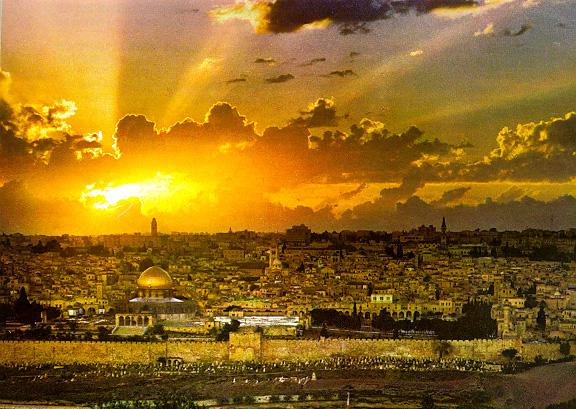
Sultan Sulieman al Azeem 'the Magnificent' (1537-1541) took charge in Palestine and rebuilt Jerusalem where his great walls stand to this day. He further improved the city's water system, installed the drinking fountains still visible in many parts of the Old City and lent his support to religious and teaching establishments. The Ottoman rule which lasted until 1918 gave Palestine its longest period of inaction, the price was one of economic stagnation, coupled with perpetuation of ignorance and inactivity. By the end of World War I, the Palestinian population was ready to revolt. In the meantime, another element was being added. Jews had played little part in the political history. The indigenous Palestinian Jewish community were mainly religious Jews. During the 19th century however, Jews seeking refuge from pogroms and anti-Semitism in Eastern Europe and Russia obtained the permission of the Ottoman rulers to emigrate to Palestine. In 1901, the Jewish National Fund was set up to finance the purchase of land for Jews in Palestine, eight years later saw the founding of Tel Aviv on land belonging to the Palestinian city of Jaffa. By the outbreak of World War I, waves of Jewish immigrants raised the Jewish population in Palestine to 60,000, less than 10% of the total population, the overwhelming majority were Palestinian Arab. Nevertheless the Zionists' slogan "A land without people for a people without land" remained convincing to western ears for many years to come. In the meantime, the European powers vied with each other to gain a foothold as they waited for the 'sick man of Europe' to die. New areas with names like the Russian Compound and the German Colony sprouted outside the city walls of Jerusalem. Many of the educational and religious institutions which still exist today - Schmidt Girls School, the Alliance Francaise and St. George's Anglican Cathedral - were founded at this time.
|
Jerusalem in the 20th Century:By dint of double dealing backed with military muscle, the British obtained control of Jerusalem along with the rest of Palestine, when the 'sick man's' possessions were carved up after World War I. The first British civil administrator Ronald Storrs, declared that all new buildings in the city should be made from local stone. The expansion of the city outside the walls continued, as both Palestinian Arabs and new Jewish immigrants constructed residential quarters spreading out from the Old City. When Britain washed its hands of the mess it had created following World War II, the United Nations Partition Plan of 1947 declared Jerusalem a corpus separatum, open to both the Jewish and Arab states. By the end of the 1948 war, the city was occupied by Israeli troops in the west, and the Jordanian Arab Legion in the east. Jerusalem retained its spiritual significance, but temporal power centers moved elsewhere. For Israel, despite the moving of the administration, West Jerusalem became a frontier town and Tel Aviv and the coastal region the economic and cultural center. The east side of the city retained its importance to Palestinians during Jordanian rule, the PLO held its first Palestine National Council conference in the Seven Arches Hotel in Jerusalem in May 1964. In June 1967, East Jerusalem and the Old City were occupied by the Israeli army. Two weeks after the end of the war, Israel unilaterally annexed East Jerusalem and declared the city the 'eternal, united capital of Israel'. Today, Jerusalem still awaits final resolution of the divisions of 1948, and for all Israel's talk of eternity, the international community does not recognize its jurisdiction. Most western countries still maintain consulates in the east serving the occupied territories, as the Palestinians see the city as the capital of their future independent state. To preempt this, Israel has expanded the municipal boundaries to the very edges of Bethlehem to the south and Ramallah to the north, and ringed the Arab city with three bands of settlements. These fortress-like eyesores are physical evidence of the immense damage done to the holy city in Arab East Jerusalem by current Israeli occupiers, they distort its historical view, wasted its natural beauty and changed its divine character. To further emphasize this point, ‘in an Israeli round table discussion on architecture in Jerusalem attended by Israeli Architects and students of Architecture, (see the Jerusalem Post Monday, April 8, 1996) Ehud Olmert, Israeli mayor of West Jerusalem was accused of being blind to the ramification of ideas he bandies about. Olmert has been quoted in the press as saying he wants Jerusalem to have high-rises, to be like the 'great cities' in the West, he wants massive developments in the valley at the entrance to the city. Before leaving the said round table discussions, Olmert noted the only way to expand the city is to the east, i.e. in the direction of Arab East Jerusalem. Here we are, in a city that has not only emotional and historical importance, but spiritual meaning far beyond its physical confines, a city with its own distinctive mystique, still largely built on an intimate scale, a city with a human face. We have valleys that bring our physical setting to our feet, and every so often, we can lift our eyes to the mountains. But every bit of what we have is in danger, the quality of life in this city is going quickly to the dogs, anonymity replacing intimacy, the sky darkened, the mountains crushed under fortress Jerusalem.’ Jerusalem has seen many conquerors through its history, only time will tell who will be the next to take over Jerusalem. |
Ramallah city
| In
the hilly region of central Palestine, ten miles north of Jerusalem,
lies the pleasant city of Ramallah. Built on several hills at an
altitude of 900 meters above sea level , Ramallah enjoys a moderate
temperate climate.
The original population of Ramallah are Christians. As a result of the 1948 war, refugees from many parts of Palestine settled in Ramallah. Both Christians and Moslems now live in full harmony in the city.The population of Ramallah is forty thousand (40,000). There are eighty eight towns and Villages (88) surrounding Ramallah which makes the population of the Ramallah District two hundred and twenty thousand (220,000).The area of Ramallah is nineteen thousand Dunoums (one Dunoum is 1000 sq.m.) and the City Council took a decision to expand the city by another two thousand Dunoums.Being centrally located and well known as an open city.
|
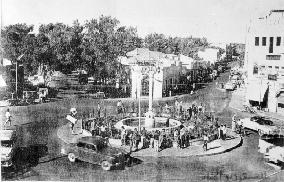
Ramallah is witnessing rapid development in all spheres. Housing projects, Banking activities, Insurance businesses, Hotel Projects and Cultural activities, make Ramallah the place to live and invest in.The late Mr.E Grant who lived in Ramallah from 1901 to 1904 says in his book that the people of Ramallah are energetic, organized and intelligent and quickly put a stranger at ease. |
Akka City "Acre"
|
Acre {ahk'-ur} (Arabic: Acca) is a coastal city of Palestine, on the Bay of Haifa. Acre is famous for its surrounding high walls and is called the city of "Sh. Ahmad Basha al-Jazzar", who prevented French Napoleon from conquering it. Acre is also famous for its old Arab inns and the mosque of Ahmad Basha al-Jazzar (shown above with the tallest minaret). To the left is a side view of al-Jazzar mosque. Acre has been under occupation since 1948. Many of the Islamic and Palestinian historic landmarks have been radically changed by occupation. |
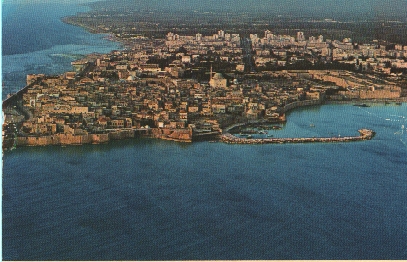 |
Haifa City
| Haifa
{hy'-fah} situated at the foot of Mount Carmel and at the southern end
of the Bay of Haifa, 19 km (12 mi) south of Acca. Haifa is Palestine's
leading Mediterranean seaport. Haifa has been under occupation since
1948. Many of its remaining mosques have been turned into bars and
museums.
|
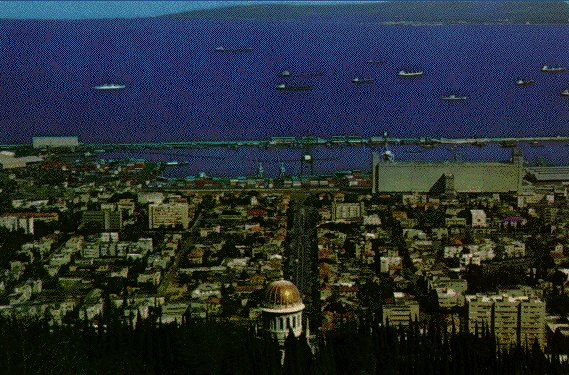 |
Tulkarem
| The city of Tulkarm is one of the cities where ancient civilizations originated. According to the excavations that took place in the northern part of the village, remains were revealed of the Kalkolit civilization, the Bronze Stone Age and the early Bronze Ages. This means that the old buildings found were built more than four thousand years BC. Many stone tools were found in the site such as knives, scrapers, etc., and other ruins belonging to the different Bronze Ages. These ruins remained largely unprotected under the Israeli Occupation. | 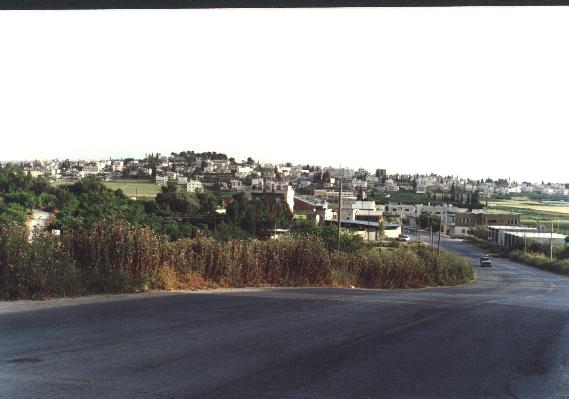 |
Hebron City " ElKhalil"
| Hebron {hee'-bruhn} (Arabic: El Khalil) is a city in the southern part of the West Bank. More than 100,000 Palestinians live in Hebron. Glassware and leather-goods manufacturing as well as food processing are the principal industries, and in the surrounding region grains, grapes, and vegetables are grown. Hebron is a sacred place for Muslims. Founded in the first half of the 2nd millennium BC, it was the home of Ibrahim (pbuh) and his family. El-Khalil is named after Khalil al-Rahman, nick name for Prophet Ibrahim (pbuh). The city was under Islamic rule from 635 to 1100, when the Crusaders gained control. Retaken by Muslims in 1260, it came iunder Ottoman control in the 16th century. Hebron was part of the British mandate of Palestine from 1922 until 1948 when it was incorporated into Jordan. Since the Six Day War of 1967 it has been under Israeli occupation. The Ibrahimi Mosque, has a burial site of Prophet Ibrahim (pbuh) and his family. | 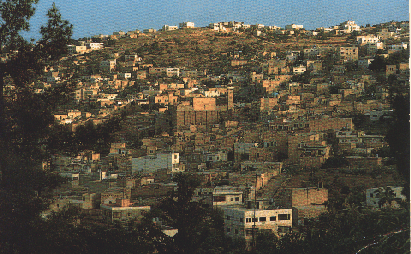 |
Nablous City
|
Nablus {Na-blos} Nablus is the largest town on the West Bank. Situated 67 kms north of Jerusalem, 570 m above sea level in the valley between the biblical Mount Ebal (called in Arabic Jabal Sitt Sulaymiyya) and Mount Gerizim (Jabal alTur). Nablus is the natural capital of the mountain region of northen Palestine. The surrounding land is notable for its olive groves and orchards, including figs, walnuts, apricots, mulberries, pomegranates and vines, with a few date palms. Yet the town boasts almost two millennia of continuous history, with buildings from Roman to |
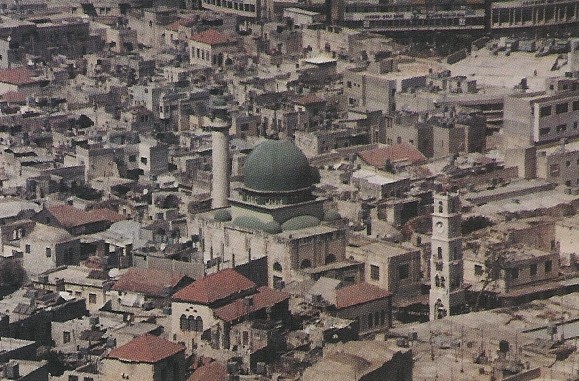 |
|
Ottoman times, shrines of biblical prophets, bath-houses, palaces and soap factories where soap is still made in the traditional way, all set amid the colourful bustle of a typical Middle Eastern market town. The city is famous of Middle Eastern sweets. Nablus has a population of 130,000 Palestinians. In 636 the Muslim Arabs opened the town. The famous tenth-century geographer al-Muqaddasi wrote that the town abounded in olives and was named "the little Damascus" and that its market place was very extensive. It had a Great Mosque very finely paved, the houses were built of stone and a stream of running water flowed through the town. In 1099, Crusaders invaded the city and took control of it, until 1187 when it was liberated by Salahuddin. At the time of Ottoman control, Nablus became capital of a district (sanjak) under the control of a local governor in the province of Damascus. The Ottomans built palaces with iron gates similar to the medieval family palaces in Italian cities. It was said that the largest building, the Tuqqan Palace, could accomodate l,OOO soldiers. Many of the religious buildings in Nablus also date from that period, as do the soap factories. |
Nazareth City " Al-Naserah"
| Nazareth
{naz'-uh-reth} (Arabic: al-Naserah) is a town in Lower Galilee (Arabic:
al-Jalil), near the Sea of Galilee. Most of the inhabitants are
Palestinians and have been under occupation since 1948.
|
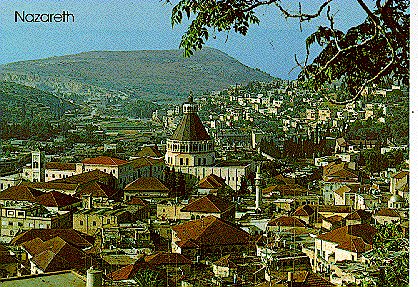 |
Jericho City " Areha"
| Jericho is the oldest town in the world, dating back more than 10,000 years. It lies 260 meters below sea level, making it also the lowest town on earth. Known as the 'City of Palms', Jericho contains some of the world's most important historic sites and is frequently mentioned in the Bible. Jericho's contribution to civilization is unique. The domestication of plants and animals and the invention of pottery took place in ancient Jericho 1000 years before Mesopotamia and Egypt, while the walls and towers of Jericho preceded the pyramids of Egypt by 4000 years. Jericho's moderate climate makes it a favorite winter resort. It is an important agricultural area, producing fresh fruits, and vegetables year round. Jericho dates, bananas and citrus fruits are especially famous. Located 36 km east of Jerusalem, Jericho is on the road to Amman and at the junction of the highway to Galilee. | 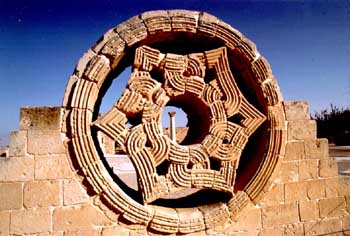 |
Gaza City
| Situated
on the western Mediterranean seashore 32 km north of the Egyptian
border, Gaza is considered one of the most ancient and historic towns in
the world. Strategically located on the Mediterranean coastal route,
ancient Gaza was a prosperous trade center and a stop on the caravan
route between Egypt and Syria. The city was first inhabited by the Canaanites and occupied by Egypt in the 15th century BC. Several hundred years later, Gaza became a chief Philistine city. Gaza is mentioned a number of times in the Bible, especially as the site where Samson brought down the Philistine temple on himself and his enemies. Captured by the Muslims around 600 AD, Gaza is the site where Prophet Mohammed's grandfather was buried. Consequently, the city became an important Islamic center. In the 12th century, it was occupied by the Crusaders but returned to Muslim control in 1187. Today, Gaza is the economic center for a region where citrus fruits and other crops are grown. The city is famous for its hand-woven carpets, wicker furniture, and pottery. Famous for its fresh seafood, Gaza has numerous restaurants along the beach as well as public parks where visitors can enjoy the pleasant Mediterranean breeze. Nightlife in Gaza is also picking up and several beach hotels offer visitors enjoyable evenings of music and dance. |
 |
Mohammad loay Copyright © 2003 All rights reserved.